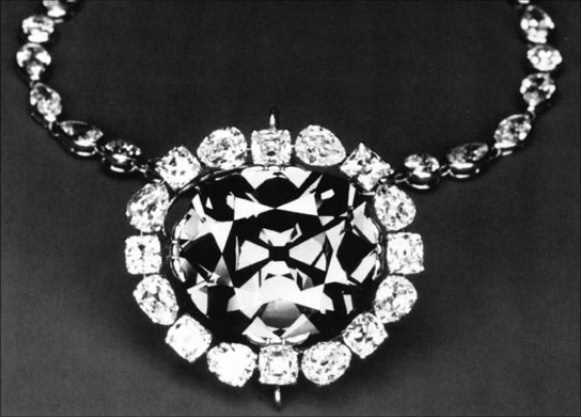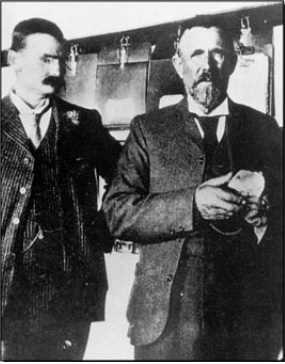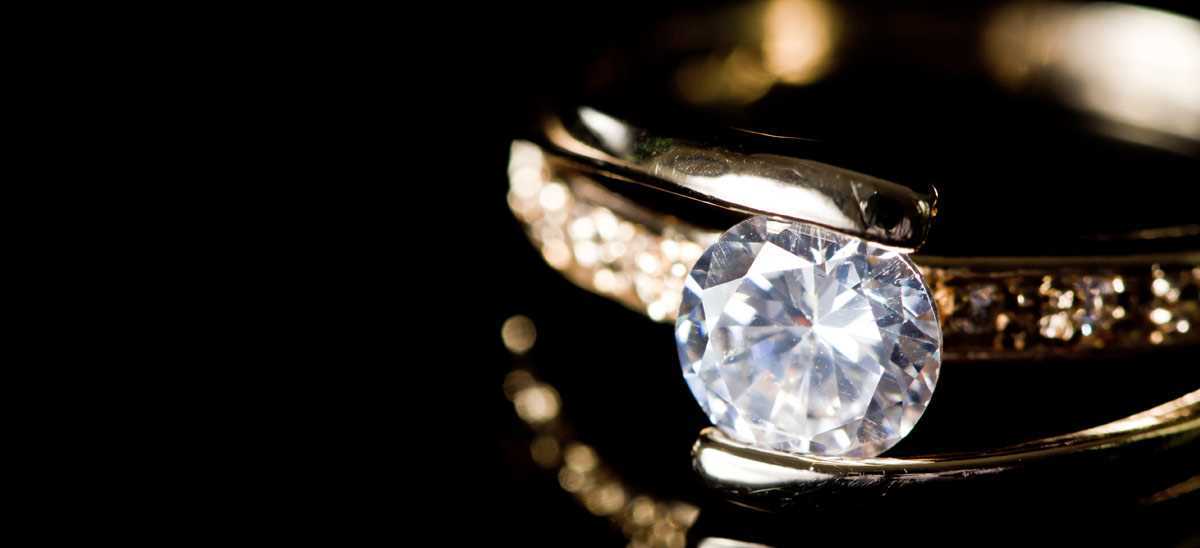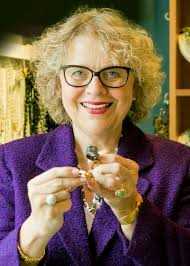Along the long road of knowledge, the diamond accompanies the history of science at the same time as that of men. A Hindu manuscript of the fourth century BC mentions the characteristics of a gem that can be said to relate to the diamond. In the first century CE, Pliny the Elder calls it adamas, which means indomitable, indestructible. Formed of carbon that crystallizes with particularities called inclusions, the diamond is sometimes colorless, sometimes colored. The unit of weight is the carat, equivalent to 0.20 grams. Once cut, it shines and fascinates for centuries.
India is the first country to commercially produce diamonds. The documents locate its beginnings around 1512. The production is concentrated first in the vicinity of a fort named Golconde, whose name is then extended to the whole region.

A diamond remains famous: the Koh-i Nor, the mountain of light. The official English version indicates that the President of the East India Company offered it to Queen Victoria in 1851. The Indians still claim today that they would have been forced to do so. This diamond weighs today. carats and is set in the crown of the late Queen Elizabeth, wife of George VI and mother of Elizabeth II. Currently, it can be seen at the Tower of London.
India has also produced an exceptional 110-carat blue diamond originally: the Hope. This one was part of the jewels of the crown of France and belonged to Marie-Antoinette. Stolen during the French Revolution, it was resized in London not to be recognized, then bought by the banker Henry Philipp Hope from which his name comes. The Cartier House owned it in 1909, and the American diamond merchant Harry Winston finally acquired it to offer it, in 1958, to the Museum of Natural History of Smithsonian Institute, Washington, where it shines now finally safe . The story tells that he would have brought bad luck to all his owners …

The discovery of diamonds in Brazil is timely, as declining Indian exploration can no longer meet Western demand. This discovery dates back to 1726 in a city in the state of Minas Gerais later christened Diamantina. A missionary who had made his first conversions in Golconde, India, would have recognized the bright pebbles remaining in the bottom of garimpeiros sieve, poor miners in search of gold.
Diamond mining in Brazil does not do justice to its motherland, Portugal. The concessions of the garimpeiros are canceled by Lisbon to be ceded to corruptors and the hard mining work is done by black slaves.
Everything must be declared. If a “negro” dares to hide the discovery of a diamond, his peers – against a reward – hasten to denounce it: the whip or even death ensues … On the other hand, if he finds a diamond of an octavo (17.2 carats or 3.44 grams), he is decorated with a garland of flowers, he is taken in procession to the administration, which gives him his freedom, and an indemnity is given to his master.
Until 1843, 1,354,700 carats were harvested, including at least 80 beautiful and large stones “reserved” for the crown of Portugal. In 1870, after years of servitude to the Portuguese government, slavery in Brazil was finally abolished. Today, the country produces diamonds through new deposits in the north and alluvial deposits in river beds.
In 1866, in South Africa, a modest girl has fun with pebbles. A neighbor notices one and offers the mother to buy it. This one gives it to him … This pebble finally reveals a diamond of 21,25 carats, truffle of inclusions, which once cut father 10,73 carats. He is baptized Eureka; Owned by the Government of South Africa, it is kept in a museum as a historical value.
Three years later, after some important finds confirming the potential of the region, thousands of prospectors come from Africa, Europe, Canada and even India. One city concentrates the commercial activity: Hopetown.
The African continent will reveal a soil rich in diamonds. So are Botswana, the Democratic Republic of the Congo, Namibia, etc., who will make ample use of their wealth.
At the turn of the last century, in 1905, Cullinan, a very pure diamond of 3,106 carats, was discovered in South Africa, which the Transvaal government offered as a birthday present to the King of England, Edward VII, as a sign of loyalty. and attachment. Cullinan is fired with nine important stones. The Cullinan I, pear-shaped weighing 530 carats, is set in the scepter at the cross of the sovereign and kept at the Tower of London.
A man marks the rest of the story: Cecil Rhodes, a smart Englishman, who gave his name to Rhodesia. Conscious that thousands of prospectors and miners bring huge quantities of diamonds and that the market can not absorb everything, he buys, between 1870 and 1880, all the surrounding mines and controls the labor force. No more white self-employed; Rhodes fires them and hires blacks. In 1888 he founded De Beers Consolidated Mines Ltd.
In order to stabilize prices and reassure investors (especially European), De Beers adjusts the quantities and categories of crude sent to the size centers, such as Antwerp in Belgium, while continuing to be the sole buyer of the production. of the African continent.

Then, under the direction of Sir Ernest Oppenheimer and later of his descendants Harry and Nicky, an era of great prosperity in the diamond industry follows.
De Beers’ subsidiary, the Central Selling Organization (CSO), currently has about 150 approved, carefully selected diamond dealers. They have a solid reputation and impressive financial strength. It is the CSO that sets the quality, quantity and price of diamonds put on the market. This international monopoly system regulates the sale of nearly 85% of rough diamonds until 1990.
In Russia, the first diamondiferous chimney was located in 1954. The dissolution of the USSR into independent states in 1991 left Russia a source of very high quality diamonds and an organized diamond industry, from ‘to the size. Russians need money quickly and the economic stakes are high. If officially, 50% of the Russian production passes by the De Beers, in fact, the country contravenes the contract which bound it to this one and sets up a circuit in full expansion.
In Australia, the sire is located in 1979 and production begins in 1982. The Argyle mine, the largest diamond deposit in the world, produces around one third of the world’s annual production, 50% of which is of high quality. gem. Highly mechanized, this mine is mined by millions of dollars.
In 1996, bad news for De Beers: Argyle announces that she does not renew her contract, she wants to sell her goods out of monopoly.
Argyle is famous for its colored diamonds. Following a large and expensive advertising campaign, diamonds of different shades of brown (shaded with yellow or orange) are now known as “champagne” or “cognac”. The mine also produces yellow, gray, blue, pink and even red diamonds, the latter being the rarest of all.
In Canada, during his voyage of 1541-1542, Jacques Cartier confused, seen from the river, the brilliant crystals of quartz with diamonds. Hence the name of “Cap Diamant”. The term “fake as a diamond in Canada” is no longer necessary!
In the 1970s, geologist Charles Fipke prospected in the Northwest Territories, eventually discovering diamond at Lac de Gras, 200 km south of the Arctic Circle. In 1998, the Ekati mine goes into production. All stones are sold outside the De Beers network. In 2004, thanks to Ekati and other mines, Canada succeeded in becoming the world’s third largest producer.
Weather conditions, Aboriginal claims, and harsh environment conservation measures make Canadian operations extremely expensive.
The Canadian size industry is booming. Canadian diamonds are identified by laser engraved logos (the maple leaf, polar bear, etc.) around their rounded edges. A registration number and a certificate of authenticity indicate their provenance.
Too often in recent years, diamonds have been used to finance arms purchases in some African countries, including Sierra Leone and Angola. To counter this movement, 53 countries where diamonds are traded and traded, such as Canada and the United States, signed in January 2003 the Kimberly Protocol, which defends the purchase of diamonds of dubious origins. Canadian diamonds have the reputation of being “clean” and their place in the market is confirmed.
The diamond world is currently experiencing intense hours. Internet sales, bleaching, laser and fracture treatment, synthetic gem-grade diamonds, the arrival of Canadian production, the Kimberly protocol, the reorganization of De Beers to direct distribution consumers, upset the game rules yet firmly established.

